|
|
 |
|
|
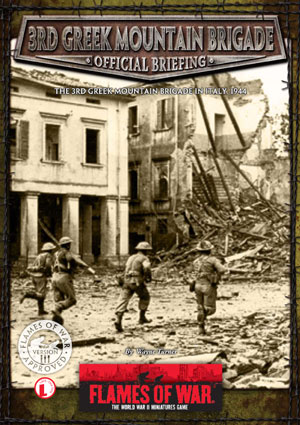
|
3rd Greek Mountain Brigade in Italy 1944
The 1st Greek Brigade was formed in Palestine in 1941. The soldiers that formed this unit were escaped Greek military personnel from Greece and Crete, and volunteer Greek overseas residents. The brigade had a total strength of 4,500 with three infantry battalions, an artillery regiment, engineer company and machine-gun company. In July 1942 the 2nd Greek Brigade was formed at Almiriya Camp in Egypt.
The 1st Greek Brigade took part in the battle of El Alamein in October-November 1942 and fought well, but due to various political struggles and disruption throughout the Greek forces in Mediterranean, the brigade was disbanded after a communist inspired mutiny in April 1944.
The most “reliable” Greek soldiers were then formed into the 3rd
Mountain Brigade under the command of Colonel Thrassivoulos Tsakalotos.
|
|
The new formation consisted of three infantry battalions, a regiment of field artillery and attached support troops, approximately 3000 men. Some of the Greeks were veterans from Albania and El Alamein, but others were yet to see action.
In August 1944 the 3rd Greek Mountain Brigade was attached to the 2nd New Zealand Division and the New Zealand commander General Freyberg inspected them at Taranto on 17 August and was impressed by the Greeks’ bearing. The Brigade then joined the New Zealanders in an exercise to familiarise the officers with all-arms co-operation and communication.
By the September the brigade was positioned near the village of
Catalica, just south of the city of Rimini. On 8 and 10 September the
brigade was engaged by two strong German attacks.
|
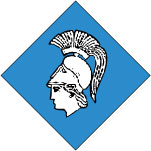 |
| The Greeks held their line and pushed the Germans back, and then launched a counterattack to take Rimini. |
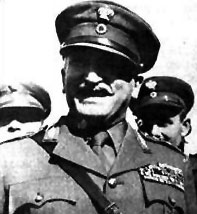
|
The Greeks were by then attached to the 1st Canadian Division, but could expect support from their New Zealand friends who were in reserve. To provide the Greeks some armoured support B squadron, 20th New Zealand Armoured Regiment was initially attached to the Greek brigade. For the protection of the tanks the 22nd New Zealand Motor Battalion was attached. Additional firepower was given to the Greek Brigade in the form of the Canadian Saskatoon Light Infantry (SLI), with a Heavy Mortar company and Machine-gun company supporting. The New Zealand 33 Anti-tank battery (17pdrs) was positioned behind the Greeks for the attack.
The attack began on 13 September with the Greeks attacking two small farm settlements on the Marano road. The two settlements (Mondaldini and Monticelli) were defended by 1. Fallschirmjäger Regiment and some Ostruppen described as Turkomen (likely a Turkestani Ostlegion battalion from the 162. Infantry Division). The Germans were well prepared and held off the Greeks.
|
|
The following day the New Zealand support was called up to aid the Greeks. 7 and 8 Troop of the B Squadron, 20th Armoured Regiment we assigned to the Greeks and took part in the attack on Monaldini, while soon after a platoon from 22nd Motor Battalion aided the attack on Monticelli with the support of 5 and 6 Troops’ Shermans. By 2000 hours the Monaldini farm had been taken, with only light casualties. The focus then turned to Monticelli, where the Greeks and New Zealanders once again attacked.
The German defenders cleared out of the position
as soon as the attackers approached and the farm was in Allied hands a
short time later.
|
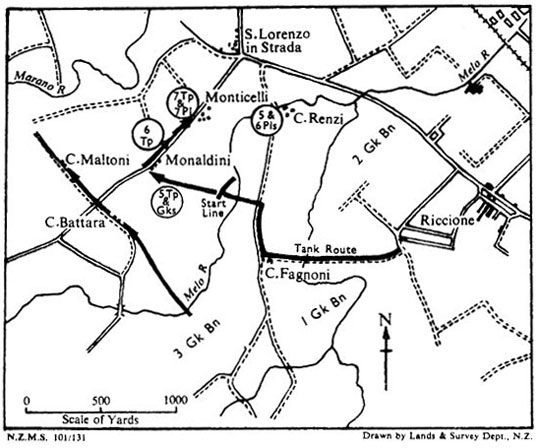
|
On 15 September the Greeks launched an assault on the Rimini airfield. The 1st Greek Battalion crossed the Marano River (in truth a stream with only a gentle flow of water) at 1000 hours, and immediately came under intense fire from German positions around the airfield. The Greeks halted to re-organise themselves for an attack. The C Squadron, 18th New Zealand Armoured Regiment replaced the 20th Armoured Regiment in the line supporting the Greeks. Air support was called in and Allied fighter/bombers attacked the western side of the airfield, and the Greeks attacked shortly afterwards.
|
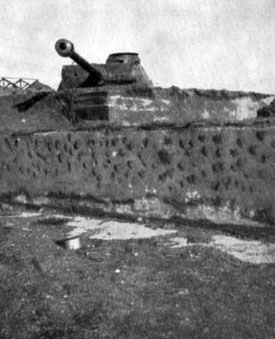
|
The 1st Battalion attacked the airfield itself,
the 2nd Battalion then attacked up the Route 16 road and the 3rd
Battalion attacked the small village of Casalecchio.
The 1st Battalion once more ran into stiff resistance from the airfield
defenders. Heavy fire from airfield inflicted heavy casualties on the
advancing Greeks, however support from the New Zealand tanks and
infantry was better co-ordinated as one of the New Zealand officers
spoke Greek. The tanks were able to fire on each house lining the south
of the airfield to ensure they weren’t occupied. As the Greeks and New
Zealanders approached the defensive positions the came under fire from
infantry, Panzerschrecks, self-propelled guns, and emplaced Panther
turrets. The heavy fire pinned the Greeks just short of the airfield.
Meanwhile the tanks edged around a hedgerow to avoid the anti-tank
fire, but soon found themselves at the forefront of the attack.
A German self-propelled gun knocked out a Sherman, but the New
Zealanders continued forward and knocked out enemy positions with
high-explosives and grenades, forcing the Germans withdraw from their
positions. The crew of the Panther turret abandoned it during the night.
|
|
The 2nd Battalion, on the right of the brigade, attacked up the Route 16 road, but became separated from their supporting New Zealand tanks. The Greeks were halted by mines and heavy defensive fire from the east side of the airfield and nearby houses.
The 3rd Battalion attacked the village of Caselecchio on the left flank, supported by New Zealand tanks and infantry.
|
|
The little village stood on a crossroads with a few houses and a church. The Greek infantry quickly cleared the houses, but the Fallschirmjäger in the church proved harder to budge. The church was finally cleared when a combined attack by Greek and New Zealand infantry and tanks finally drove the paratroopers out. However heavy machine-gun and mortar fire from the airfield halted any further advance.
The following day (16 September) the Greeks
continued to mop up around the airfield, though they held most of the
airfield, one Panther turret was still in operation.
|
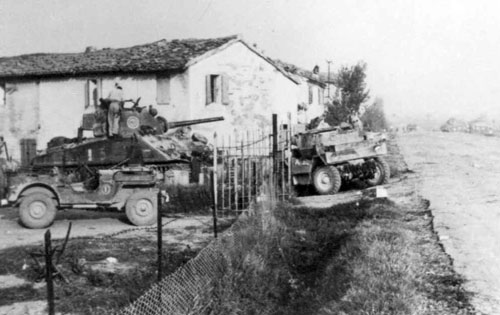
|
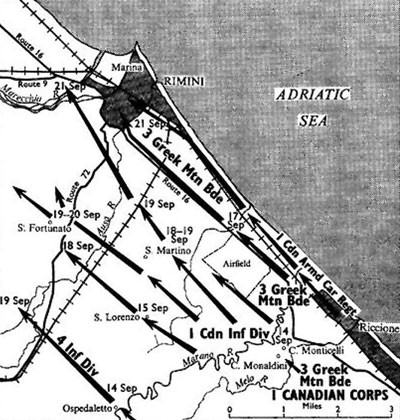 |
The 3rd Battalion advanced up the left through the hedges and ditches
beyond Caselecchio until they came level with the 1st Battalion in the
centre, their task was made difficult as they had to occasionally clear
minefields and were under constant fire.
The 2nd Greek Battalion advanced up the right flank of the airfield. Anti-tank fire was lighter than the previous day.
The following day the three battalions continued their advance. Several attempts were made to knock out the remaining Panther turret with aircraft and artillery, but it finally fell to one of the New Zealand Shermans to work around the flank of the turret.
It fired several anti-tank rounds into the turret before the crew were eventually persuaded to evacuate.
Once the airfield was taken the 3rd Greek Mountain Brigade turned its attention towards Rimini itself. On 18 September the 2nd and 3rd Battalion pushed on to Rimini, towards the coastal suburbs of the town. They encountered heavy resistance once again from the German Fallschirmjäger, but with the aid of New Zealand and Canadian support were finally able to push into the outskirts of the town on 21 September.
|
|
They pushed into Rimini from the south, only to
find the city abandoned by the Germans, who were forced to withdraw
after the fall of Fortunato.
Shortly after the fall of Rimini the brigade was sent to Greece to seize control of Athens and prevent the ELAS communists from taking control of the country after to withdrawal of the Germans.
After fighting in the Civil War the 3rd Greek Mountain brigade went on to form the basis of today’s regular Greek army.
|
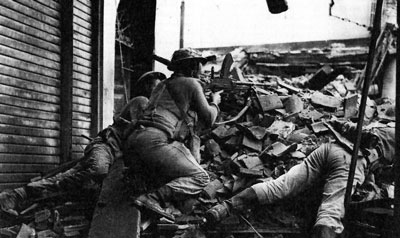 |
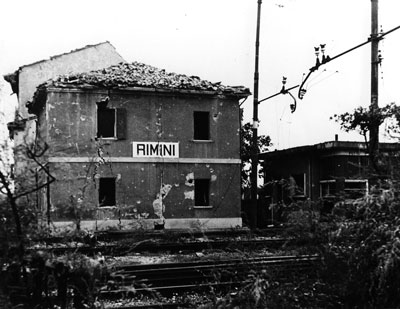 |
3rd Greek Mountain Brigade in Flames Of War
The linked Intelligence Briefing allows you to field a Greek Mountain
Infantry Company for this period of fighting. They are able to take
supporting Canadian and New Zealand troops. Last updated on 4 February 2014.
Greek Mountain Infantry Company 1944 (PDF)...
Miniatures
The Greeks were supplied by the British so all uniforms are the same as the British. They did wear a Brigade patch (as shown above) in place of the usual British or Commonwealth division patch.
Wayne
|
Last Updated On Tuesday, February 4, 2014 by Wayne at Battlefront
|
|
|